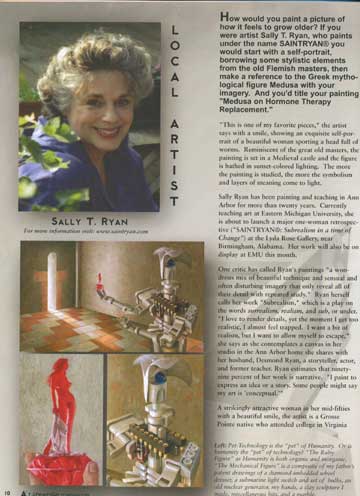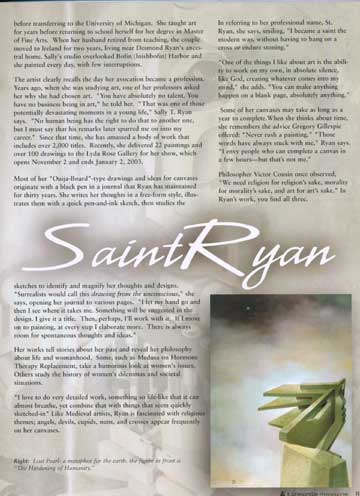
To Website Directory



illustration below, page 10 -
Left: Pet- Technology is the "pet" of Humanity. Or is humanity the "pet of technology? "The Ruby Figure" as Humanity is both orgqnic and inorganic. The Mechanical Figure is a composite of my father's patent drawings of a diamond-imbedded wheel dresser, a submarine light switch and set of bulbs, an old nuclear generator, my hands, a clay sculpture I made, miscellaneous bits, and a marble.
illustration below, page 11 -
Right: Lost Pearl - a metaphor for the earth. Front figure: "The Hardening of Humanity."
How would you paint a picture of how it feels to grow older? If you were artist Sally T. Ryan, who paints under the name SAINTRYAN® you would start with a self-portrait, borrowing some stylistic elements from the old Flemish masters, then make a reference to the Greek mythological figure Medusa with your imagery. And you'd title your painting "Medusa on Hormone Therapy Replacement.""This is one of my favorite pieces," the artist says with a smile, showing an exquisite self-portrait of a beautiful woman sporting a head full of worms. Reminiscent of the great old masters, the painting is set in a Medieval castle and the figure is bathed in sunset-colored lighting. The more the painting is studied, the more the symbolism and layers of meaning come to light.
Sally Ryan has been painting and teaching in Ann Arbor for more than twenty years. Currently teaching art at Eastern Michigan University, she is about to launch a major one-woman retrospective ("SAINTRYAN¨: Subrealism in a Time of Change") at the Lyda Rose Gallery, near Birmingham, Alabama. Her work will also be on display at EMU this month.
One critic has called Ryan's paintings a "wonderous mix of beautiful technique and sensual and often disturbing imagery that only reveal all of their detail with repeated study." Ryan herself calls her work "Subrealism," which is a play on the words surrealism, realism, and sub, or under. "I love to render details, yet the moment I get too realistic, I almost feel trapped. I want a bit of realism but I want to allow myself to escape, " she says as she contemplates a canvas in her studio in the Ann Arbor home she shares with her husband, Desmond Ryan, a storyteller, actor, and former teacher. Ryan estimates that ninety-nine percent of her work is narrative. "I paint to express an idea or story. some people might say my art is 'conceptual.'"
A strikingly attractive woman in her mid-fifties with a beautiful smile, the artist is a Grosse Pointe native who attended college in Virginia
before transferring to the University of Michigan. She taught art for years before returning to school herself for her degree in Master of Fine Arts. When her husband retired from teaching, the couple moved to Ireland for two years, living near Desmond Ryan's ancestral home. Sally's studio overlooked Bofin (Inishbofin) Harbor and she painted every day, with few interruptions.
The artist clearly recalls the day her avocation became a profession. Years ago, when she was studying art, one of her professors asked her why she had chosen art. "You have absolutely no talent. You have no business being in art," he told her." "That was one of those potentially devastating moments in a young life," Sally T. Ryan says. "No human being has the right to do that to another one, but I must say that his remarks later spurred me on into my career. Since that time, she has amassed a body of work that includes over 2,000 titles. Recently, she delivered 22 paintings and over 100 drawings to the Lyda Rose Gallery for her show, which opens November 2 and ends January 2, 2003.
Most of her "Ouija-Board"-type drawings and ideas for canvases originate with a black pen in a journal that Ryan has maintained for thirty years. She writes her thoughts in a free-form style, illustrates them with a quick pen-and-ink sketch, then studies the sketches to identify and magnify her thoughts and designs. "Surrealists would call this drawing from the unconscious," she says. Opening her journal to various pages. "I let my hand go and then I see where it takes me. Something will be suggested in the design. I give it a title. Then, perhaps, I'll work with it. If I move on to painting, at every step I elaborate more. There is always room for spontaneous thoughts and ideas."
Her works tell stories about her past and reveal her philosophy about life and womanhood. Some, such as Medusa on Hormone Therapy Replacement, take a humorous look at women's issues. Others study the history of women's dilemmas and societal situations.
"I love to do very detailed work, something so life-like that it can almost breathe, yet combine that with things that seem quickly sketched-in." Like Medieval artists, Ryan is fascinated with religioys themes; angels, devils, cupids, nuns, and crosses appear frequently on her canvases.
In referring to her professional name, St. Ryan, she says, smiling, "I became a saint the modern way, without having to hang on a cross or endure stoning."
"One of the things I like about art is the ability to work on my own, in absolute silence, like God, creating whatever comes into my mind," she adds. "You can make anything happen on a blank page, absolutely anything."
Some of her canvases may take as long as a year to complete. When she thinks about time, she remembers the advice Gregory Gillespie offered: "Never rush a painting." "Those words have always stuck with me," Ryan says. "I envy people who can complete a canvas in a few hours - but that 's not me."
Philosopher Victor Cousin once observed, "We need religion for religion's sake, morality for morality's sake, and art for art's sake." In Ryan's work, you find all three.